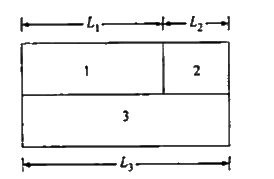વહન સ્તરીય જ રહે તે રીતે 2×10−3m ત્રિજ્યાની ધમનીમાંથી લોહીના વહનનો દર કેટલો હશે ? (લોહીની શ્યાનતા 2.084×10−3 Pa s લો.)
Step by step video & image solution for વહન સ્તરીય જ રહે તે રીતે 2 xx 10^(-3) m ત્રિજ્યાની ધમનીમાંથી લોહીના વહનનો દર કેટલો હશે ? (લોહીની શ્યાનતા 2.084 xx 10^(-3) Pa s લો.) by Physics experts to help you in doubts & scoring excellent marks in Class 11 exams.
Updated on:21/07/2023Topper's Solved these Questions
Similar Questions
સમજાવો, શા માટે માનવમાં પગ આગળ લોહીનું દબાણ (blood pressure), મગજ આગળ હોય તે કરતાં વધુ હોય છે.
View Solution2.5 kg દળની એક દોરી 200 Nના તણાવ હેઠળ છે. તણાવવાળી દોરીની લંબાઈ 20.0 m છે. જો દોરીના એક છેડે એક લંબગત આંચકો (Jerk) આપવામાં આવે, તો તે વિક્ષોભને બીજા છેડે પહોંચતાં કેટલો સમય લાગે ?
View Solutionએક મિનિટમાં 3.0 લિટરના દરથી પસાર થતા પાણીને ગિઝર 27∘C થી 77∘C સુધી ગરમ કરે છે. જો ગિઝર, ગૅસ બર્નર પર કાર્ય કરતું હોય અને બળતણ (combustion) ઉષ્મા 4.0X104Jg હોય, તો બળતણના વપરાશનો દર કેટલો હશે ?
View SolutionDetermine the work done by an ideal gas doing 1 rarr 4 rarr 3rarr 2 rarr 1 . Given P_(1) = 10^(5) Pa, P_(0) = 3 xx 10^(5) Pa, P_(3) = 4 xx 10^(5) Pa and V_(2) - V_(1) = 10 L .
View Solution(a) यदि किसी धमनी में रुधिर का प्रवाह पटलिय प्रवाह ही बनाये रखना हैं तो 2×10−3m त्रिज्या की किसी धमनी में रुधिर-प्रवाह की अधिकतम चाल क्या होनी चाहिए? (b) तदनुरूपी प्रवाह-दर क्या हैं? (रुधिर की श्यानता 2.084×10−3Pas लीजिये)।
View Solution(a) यदि किसी धमनी में रुधिर का पटलीय प्रवाह ही बनाए रखना है , तो 2×10−3m त्रिज्या की किसी धमनी में रुधिर - प्रवाह की अधिकतम चाल क्या होनी चाहिए ? (b) तदनुरूपी प्रवाह - दर क्या है ? ( रुधिर की श्यानता 2.084×10−3 Pa-s लीजिए )।
View SolutionThe speed of light in air is 3 xx 10^(8)m//s and that in diamond is 1.4 xx 10^(3) m/s. The refractive index of diamond is
View SolutionThree metal rods are located relative to each other shown in figure - 6.101, where L1+L2=L3 Values of density and Young's modulus of the three materials are:
(ρ1)=2.7×103kg/m3 y1=7×1010Pa,
(ρ1)=11.3×103kg/m3 Y2=1.6×1010pa,
(ρ1)=8.8×103kg/m3 Y3=11×1010pa If L3=1.5m What musht the ratio L1/L_(2) be if a sound wave is to travel the length of rods 1 and 2 in the same time as required to travel the length of rod 3 ?
View SolutionWhat is the largest average velocity of blood flow in an artery of radius 2 times 10^-3 m if the flow must remain laminar?(b) What is the corresponding flow rate?(take viscosity of blood to be 2.084 times 10^-3 Pa s )
View SolutionWhat is the largest average velocity of blood flow in an artery of radius 2×10−3m if the flow must remain laminar?(b) What is the corresponding flow rate?(take viscosity of blood to be 2.084×10−3Pas)
View SolutionWhat is the largest average velocity of blood flow in an artery of radius 2 times 10^-3 m if the flow must remain laminar?(b) What is the corresponding flow rate?(take viscosity of blood to be 2.084 times 10^-3 Pa s )
View SolutionWhat is the largest average velocity of blood flow in an artery of radius 2×10−3m if the flow must remain laminar?(b) What is the corresponding flow rate?(take viscosity of blood to be 2.084×10−3Pas)
View SolutionDetermine the work done by an ideal gas doing 1→4→3→2→1.
Given P1=105Pa,P0=3×105Pa,P3=4×105Pa and V2−V1=10L.

View SolutionA thermodynamic process is shown in the following figure. The process and volumes corresponding to some points in the figure are: P_(A) =3 xx 10^(3)Pa , V_(A) =2 xx 10^(-3) m^(-3) , P_(B) = 3 xx 10^(4) Pa, V_(D) = 2 xx 10^(-3) m^(3) In process AB, 600J of heat is added to the system and in the process BC, 200J of heat is added to the system. the change in internla energy of the system in the process AC would be
View SolutionDetermine the work done by an ideal gas doing 1 rarr 4 rarr 3rarr 2 rarr 1 . Given P_(1) = 10^(5) Pa, P_(0) = 3 xx 10^(5) Pa, P_(3) = 4 xx 10^(5) Pa and V_(2) - V_(1) = 10 L .
View Solution(a) What is the largest average velocity of blood flow in an artery of radius2×10−3m if the flow must remain laminar? (b) What is the corresponding flow rate? (Take viscosity of blood to be 2.084×10−3Pa s).
View Solution
